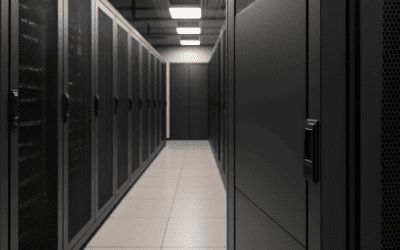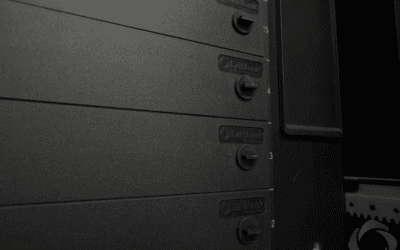Defining and Being a Green Data Center
Organizations becoming “green” is a term we hear a lot nowadays. And now, as more people seek green data center solutions, it’s time to ask: how can an organization use advanced technology to improve its energy efficiency?
Read on to learn more about possible green data center solutions for your company’s buildings.
In the article:
[—ATOC—]
[—TAG:h2—]
What Is a Green Data Center?
What is meant by the term green data center, and how is it different from a traditional data center?
Green data centers are designed for maximum energy efficiency.
While data center management is essential for many companies to maintain a site and their technologies, they are major energy drainers. But a green one allows for the storage, management, and dissemination of information while also reducing the environmental impact. You don’t need to sacrifice performance to keep a sustainable, eco-friendly company.
There are two targets to meet when data center providers strive to become greener: energy resources and energy efficiency .
Where does the power come from for your facilities?
Using renewable resources like solar is a greener option. The more unused power that your systems generate, the less sustainable your operation is.
Green Data Centers in Action
So what does a green data center look like in reality?
With the growth of servers used in facilities, equipment needs to catch up to the technologies available to help the environment. For example, a business needs to keep its servers’ operations cool. Installing an air cooling solution (and not just running an air conditioner) can save energy for the environment and provide a significant cost advantage.
Going green often comes down to infrastructure. Ensuring that a facility relies on updated IT equipment means it will run more efficiently. And when a site can reduce energy consumption , less energy usage will also save customers and businesses a lot of money.
Energy Sources for Powering Green Data Centers
Beyond becoming energy efficient in how you use your servers, you can also consider how your technology is powered. Does your business rely on limited resources such as fossil fuels? Or does your infrastructure allow for a strategic switch to renewable energy?
Renewable energy sources such as hydroelectricity, solar, biomass, wind energy, and more allow sustainable data centers to minimize their carbon footprint. You might even be able to obtain these renewable energy sources for a lower cost because of clean energy incentives from government organizations.
Clients want to know that your organization is working toward something better than just numbers. And with the low cost of energy, this efficiency may just be seen in a lower cost left to clients!
Measuring Energy Savings and Certifications
While investing in efficient technology, reducing waste, and using IT equipment on renewable energy sources are commendable acts, it can be difficult to know if you’re hitting your targets. This is where having the right metrics available is crucial. You can measure just how much you reduce power consumption. With the statistics you gather, you may even qualify for an Energy Star certification based on its requirements.
● Power Usage Effectiveness
Power usage effectiveness is how much energy you need to maintain the data center’s IT equipment compared to how much it actually uses. To figure out your PUE, divide the amount of electricity that enters to power the IT equipment — not on other services such as air cooling. The ideal ratio is 1, but the average is 1.7-2.5 for the data center industry. You can also use our PUE calculator for a quick, simple calculation.
● Carbon Usage Effectiveness
When it comes to sustainability, reducing or eliminating carbon emissions is a key part of the conversation. Carbon Usage Effectiveness (CUE) measures the sustainability of a data center focused on carbon rather than overall power. So here, the ratio is carbon emitted by the data center overall to power used to power the IT equipment only. Reducing carbon emissions is a key part of sustainability, so reducing the carbon emissions of a facility is crucial for going green.
How Do You Make a Green Data Center?
Luckily for every data center facility, sustainability isn’t accomplished in only one way. Certain sustainability measures are not feasible for everyone, so finding what can work for your building is important. Providers can highlight the pros and cons of various green data center solutions and help you find what works best for you.
Here are some examples of how to decrease energy consumption and increase efficiency for data centers.
● Low Power Servers — Decrease Power Consumption (And Costs)
Low power servers are more efficient than your average tools. The servers will use smartphone computing to balance consumption and performance, reducing the power required while also lowering the costs to operate data centers. Your information will be safe but won’t need the expected amount of energy for typical data centers.
● Modular Data Centers — Data Capacity On-the-Go
Ready to take your data centers on the go? Modular data centers are portable buildings that can be placed anywhere. It can handle a high density of information but all in an efficient pod. By not keeping your data centers in stuffy buildings, you are also saving on cooling.
● Free Air Cooling — Use Outdoor Air if Your Location Allows
Open up those doors and let nature do the cooling. When you have outdoor air circulating in data centers, this is known as free air cooling. It may not work for everyone. For example, data centers in hotter climates won’t be able to implement this strategy. But for cool climates, this is a premium option for cooling efficiency!
● Cold and Hot Aisle Containment — Keep Cool with Recused Air
For both cold and hot aisle containment , you have rows of racks that face each other at the backs of the servers. This works for cooling as the heat from the servers is pumped to cooling units to produce cold air. Hot aisle containment is typically more effective, but both are better than traditional methods for keeping the heat out of facilities.
● Reusing Waste Heat — Share the Power
Rather than turning heat into cold air, an efficient way of using that heat could be all you need! Reuse that heat for the community. For example, share the heat with homes, local projects, and more. Hot air doesn’t need to be the enemy. Rather, it can help others and be a benefit.
● Ultrasonic Humidification — Prevent Damage to Servers
We’ve been talking a lot about cool and hot air. But what about humidity? Humidity is often required to keep servers in the best possible condition. Without it, expensive investments may be lost. But as cold and hot air is moved around, this could lead to the lack of proper humidity. But ultrasonic humidification creates moisture but uses 90% less energy than traditional methods such as resistance steam humidifiers — a great way to protect investments and the environment.
● Evaporative Cooling Systems — Air Conditioning for Less Energy
With evaporative cooling, you have one of the best systems for using less electricity. It reduces heat by evaporating water, functioning as a great alternative to air conditioners. You might see two different versions of this: evaporation pads and high-pressure spray systems. The pads need less energy and less space, often making it the preferable option for most facilities.
Learn How to Become a Green Data Center
Customers and employees alike want to know what organizations are doing to be energy efficient and reduce their environmental impact.
If you’re looking to reduce energy consumption in your facility, becoming a green data center is a great way to do it! This green data center case study shows you just how much of a difference being “greener” could make.
Find out more about the advantages and disadvantages of being a green data center to keep you informed on the best ways to be sustainable when it comes to your data center.



